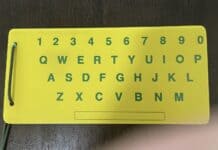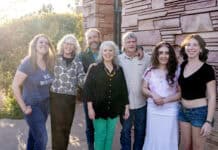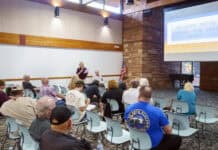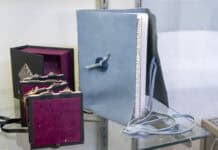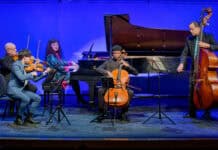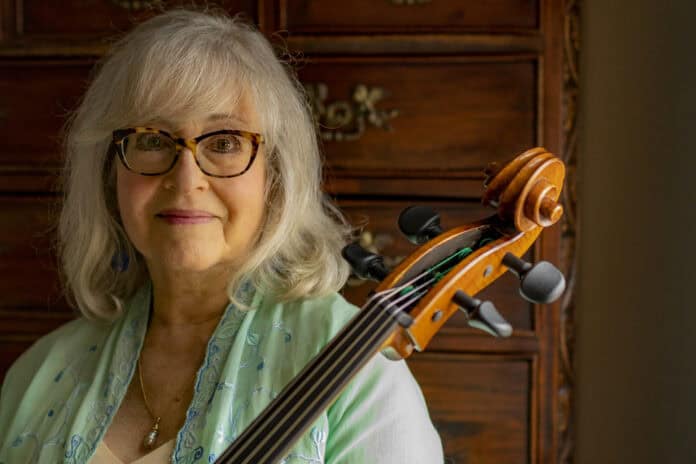
In the mood for a musical detective story? Cellist and author Janet Horvath will be appearing at the Mary D. Fisher Theatre on Saturday, Oct. 26, to discuss her book “The Cello Still Sings,” an account of uncovering her father’s history with the Ex-Concentration Camp Orchestra in the aftermath of the Holocaust, as part of the Red Rocks Music Festival.
A student of Janos Starker, who was regarded as one of the finest cellists of the twentieth century, Horvath spent a brief period with the Indianapolis Symphony before becoming associate principal cello in the Minnesota Orchestra, where she spent 32 years from 1980 to 2012.
“Both my parents were professional musicians,” Horvath said. “When my mother was teaching piano, she taught real young children, I would hear them when I was three, four years old, and I would go down after she was done and pick out the tunes on the piano. And they thought, my goodness, she’s so talented, she can pick this out by ear, start her lessons, but let’s not waste her on the piano … it would be so glamorous for a woman to play the cello! She’ll come out in a long dress on stage, you know. This was at a time when there weren’t very many female cellists. Of course there are now. But they didn’t project how tiny I’d be.”
Her father, George [Gyuri] Horvath, was himself a cellist, and spent 38 years with the Toronto Symphony after emigrating to Canada in the aftermath of World War II.
“They got me a half-sized cello and started me on the cello when I was nine,” Horvath recalled. “And no other teacher was good enough for my father. My father was from the old school, where they practiced etudes and scales, and he was appalled that my teacher wanted to play duets. So there was a constant battle. He wanted to teach me and I wouldn’t listen to him, he’d get impatient with me, then we’d switch to another teacher and he wouldn’t find that satisfactory, so we went back and forth. In the meantime, I became quite a good pianist until I was about 16, when I got a scholarship to go to Interlochen, which is a famous summer music program, and I fell in love with the cello there. And despite the fact that it was my sixteenth birthday, and I came home and found a grand piano in the living room with a huge pink bow around it, I basically just didn’t notice it and said I was in love with the cello … The rest is history.”
Horvath gradually realized, however, that other parts of her family’s history were less straightforward.
“My parents, like many other Holocaust survivors, never spoke about it,” Horvath said. “We, over the years, would hear stories that we weren’t sure our parents whispered into our ears, or maybe we heard them from other relatives, or we read them, or we dreamt them — no confrontation of the actual facts between us. And then I was busy with my own career and my own family and it seemed too late for questions … We didn’t want to cause them further pain. Until that accidental question.”
The Accidental Question
The accidental question came on a dirty winter day in 2009, when she was taking her father, then 87, to a doctor’s appointment.
“My father could be difficult to make small talk with, and I thought, oh, he loves to talk shop,” Horvath remembered. “And he’d played with all the most famous maestros in Europe prior to the war, he was in the Budapest Symphony when he was 20, so I thought, I’ve never asked him about my own personal idol. So I said, ‘Dad, did you ever play with Leonard Bernstein?’ And it was as if he passed out.
“I looked over at him, and he put his hand to his cheek and his eyes seemed to roll back into his head. I thought maybe I should pull over — what’s going on? And before I could pull over, he came to, and he said, ‘Yes, it was a very hot day. He was just a kid and he came to Landsberg, Germany, and he played in the DP camps. It was just fantastic. He played “Rhapsody in Blue” and I talked to him and I said I want to come to America.’ He remembered the program, and then he shook his head and it was as if the memory left him, or he realized what he was saying and didn’t want to talk any more.”
After that discovery, Horvath turned to the internet and discovered there had been a printed program for the concert, a copy of which was housed at the Museum of Jewish Heritage in New York City.
“I did get to go to New York shortly thereafter, three months later or so, when the Minnesota orchestra had a Carnegie Hall concert, and I raced down to Battery Park to the museum, where the archivist greeted me with long white gloves,” Horvath said. “She reached into these archival boxes and pulled out four teeny-tiny black-and-white pictures, and I said, ‘There! There’s my father! With Leonard Bernstein!’ I had imagined a hundred-piece orchestra like the one I played in, but it was only 17 Holocaust survivors, musicians. Two cellists — one was my father.”
Bernstein was on a European conducting tour at the time in the aftermath of the Mitropoulos affair and his failure to secure the reversion of the music directorship of the Boston Symphony.
“I blew up a picture to large size … so that I could bring it to Toronto and see if he would be able to identify anybody as yet unidentified,” Horvath said. “It turned out he said, ‘I sat on the bus all the time with David Arben, who got into the Philadelphia Orchestra.’ I said, ‘What do you mean, all the time?’ And so my father didn’t play two concerts. He played two with Leonard Bernstein, but he played 200 concerts, because the group was bussed all over Bavaria in the American zone after the war to bring morale-boosting programmes to those still languishing in DP camps, waiting for news of loved ones, waiting for the right paperwork to leave Europe. He played from 1946 to 1948 with these other musicians. I thought wow, this is quite a story, and I really felt it was important for people to know how people, after such atrocity, put their lives back together.
“My father passed away, but before he died that same year, he saw how much I was wanting to know, and that I found these photographs and I found this program, and then eventually I stumbled upon that there was a documentary made, and my father is in the movie in still pictures, because they didn’t know my father was still with us. There were closeups of him. We watched it together, holding hands, and he was like, ‘There I am! It’s me! I had so much hair!’ He was so galvanized by my enthusiasm that he started writing late at night in a very Parkinsonial script, cramped, black little handwriting — in Hungarian, which I speak all right, but can’t spell — and he wrote down his testimony for me. When he read it to me in Hungarian, it was merely a few weeks before he passed away. So I got his story. I was very lucky. And then I had a couple of opportunities to go make pilgrimages to these places that he had played, and where they had lived, and where he had been in slave labor, and I tried to piece the whole story together.”
Research
When she retired in 2012, Horvath went back to college at Hamlin University to get an MFA in creative writing. Although she had previously published a well-received book on injury prevention for musicians, “Playing Less Hurt,” Horvath felt that she needed more professional experience with words to tell her father’s story to the greatest effect.
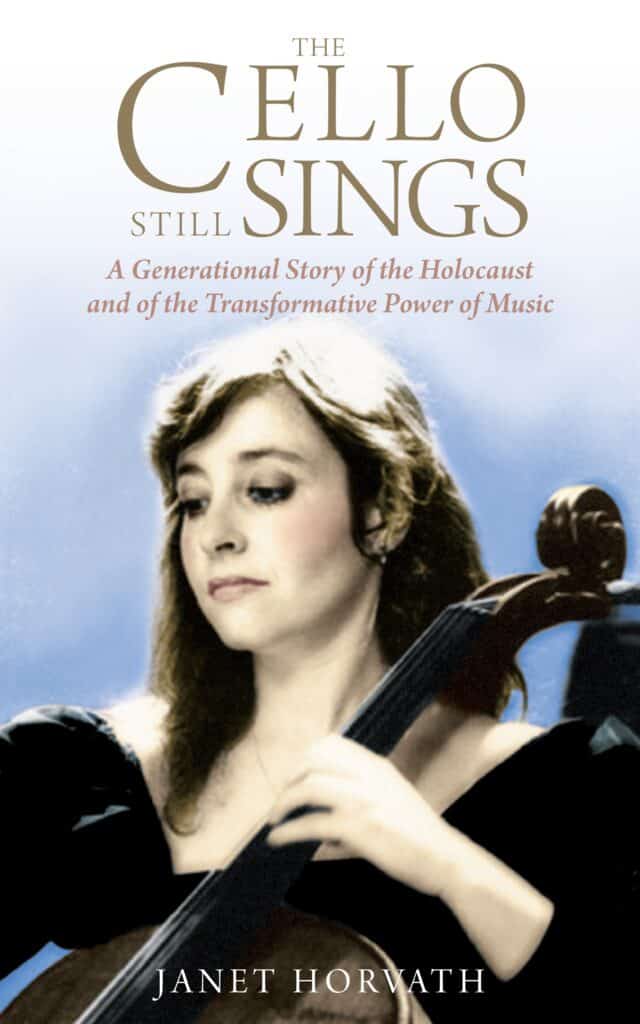
“I unravel the story like a mystery story, like it was for me,” Horvath said. “Ten years it took me to write the book, including the four years at school … I kept finding documents. At the United States Holocaust Memorial Museum, I remember an archivist was assigned to me to help me, and she says, ‘Oh, in Germany they were very meticulous about their records, the Nazis, but by the time they got to Hungary, which was already 1944, it was very fast, we don’t have any records and I don’t think you’re going to find anything about Hungary, but we’ll try.’ And I’m standing over her shoulders while she’s seated and looking at microfilm … she’s leafing through these little documents, and I say, ‘Wait, wait, wait, there! Stop! That’s my father’s signature!’ And sure enough, there was a document that my parents, both of them, signed, and my mother’s brother and my father’s sister when they escaped from Budapest after the war to get to Munich.”
Even this casually-found document, which specified her parents’ preferred destinations for emigration, turned out to be a revelation.
“I knew their first choice was the United States,” Horvath said. “I had no idea their second choice was South America. And their third choice was Canada, because I could imagine my mother had no clue as to where Canada was … At the time the only way to get paperwork to Canada was if you were in an occupation that Canada needed, so my father said he was a farmer and my mother said she was a seamstress. And when they got their papers … at the inspection, the person said to my father, ‘These hands have never farmed in their life!’ And my father said, ‘Well, I can learn!’
“There’s a lot of stories in there, but there’s also a lot of humor. I talk about the foibles of growing up with musician parents and trying to learn an instrument, and the funny stories that happened as I became a professional … And there’s a lot of recipes and food stories because my mother was an exceptional cook. My thesis adviser used to say, ‘You know, Janet, every time I read this, I’m getting hungry.’”
“I figured out a lot of things in writing the book,” Horvath said of how discovering this history affected her understanding of her own life and childhood. “There were so many things growing up that I thought were unfair, or I didn’t understand. I was already an adult, and I was taking a walk with a friend, her parents were also Hungarian survivors, and I don’t know how it came up in conversation, but suddenly I said, ‘You know, I never was allowed to sleep over anywhere, to a friend’s house,’ and she said, ‘Oh, really? Because I never was, either.’ Exploring the subject, we realized that our parents had this terrible fear, because in their day, when families weren’t together and the Nazis came in, they were separated for ever. They were afraid to have us be alone and separate. There are so many other things that have carried over.”
Playing Landsberg
Another part of her father’s story that carried over to her own life took place in 2017, when she received a surprise phone call from Germany.
“I go to answer it, and the woman has a strong German accent, and says, ‘Yes, Janet, it’s so wonderful to finally get a hold of you … It must come from people like me’ — she means German non-Jewish people — ‘that we have to teach the next generation, and you know, we’re going to have a concert next year in Landsberg’ —which was where the Bernstein concert had taken place — ‘and would you do us the honor to come to Landsberg next year in May?’
“Well, sure, it might be nice. Spring in Germany, why not?” Horvath recalled. “And then she says, ‘You know, we like to have the same program that was with Bernstein in 1948. Would you do us the honor to play “Kol Nidrei” with the Landsberg school orchestra?’
“Now, ‘Kol Nidrei’ is a piece that all cellists know, but that, moreover, all Jewish people know,” Horvath explained. “It’s played or sung in every synagogue all over the world on that night [Yom Kippur]. It had a tremendous import for our community, but also for me personally. So for her to ask me to play that piece in Germany, in the place to the day that my father played with Leonard Bernstein 70 years before, just made me weep. I was nervous about it for a whole year before I got there.
“Forty other people whose parents had an association with that DP camp, some of whom had been born in that DP camp, some of whom had been to that concert in 1948, we descended up on Landsberg and we were wined and dined and educated and entertained for a week. It was a reconciliatory experience … It felt like an out-of-body experience when I whipped those kids into shape — they sounded like any junior high orchestra until we really worked to put it together, and we all played better than we knew we could.”
“I wanted to leave the book with that beautiful coming-together experience to show that it’s possible to come together after such horrors,” Horvath said. “My whole premise throughout is that music can bring people together. It’s transformative, it’s wordless. All ages, all cultures, all nationalities, all religions can come together with the soulful inspiration of music to come to some understanding … That’s what my parents tried to do after their experiences not only in Germany but back in Toronto, and that’s what I’ve tried to continue.”


